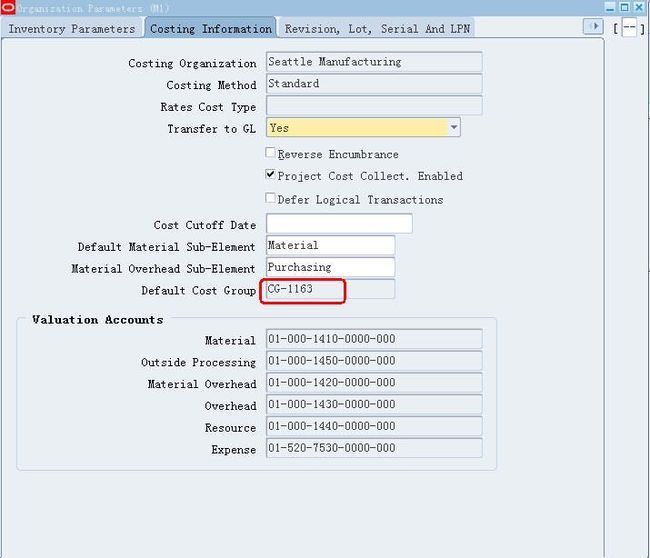Cost Group
A Cost Group is the set of accounts that hold on hand inventory. Before the advent of Cost Groups, subinventories in an Oracle Inventory organization defined both the physical and accounting attributes of the material. Different subinventories represented functional/processing requirements, packaging/material handling characteristics or storage/control characteristics. In each warehouse zone, different accounts were maintained by creating separate subinventories, and preassigning locators to each subinventory. Thus a single physical area of the warehouse was subdivided to represent the different accounts which are present in this area.
A Cost Group is assigned whenever inventory is introduced into the warehouse.
http://docs.oracle.com/cd/E18727_01/doc.121/e13434/T210618T210754.htm
Frequently Asked Questions About Cost Group
-
What is a Cost Group?
A Cost Group is a set of related financial accounts, representing ownership of inventory. Think of this as the accounts that used to be on the accounting tab of the subinventory form.
-
Does the Cost Group change when inventory is moved?
Cost Group is not changed by a Subinventory Transfer. Inventory retains the originally assigned Cost Group throughout any movements within the same organization. When an InterOrg Transfer is performed, a new Cost Group is assigned based on the Cost Group Rules for the destination organization.
-
How can I change the Cost Group assigned to inventory?
The Cost Group Update transaction is specifically designed to do this. The physical location of the inventory is managed by a Subinventory Transfer, and ownership is separately managed by a Cost Group Update.
-
What is the difference of a Oracle Warehouse Management Cost Group and a Project Manufacturing Cost Group?
They are the same thing. If the organization is a Project Manufacturing organization, the PJM cost group will always be assigned to project inventory regardless of the rules you set up. A user cannot transfer material that belongs to a project out of the project's cost group.
-
What if I want to derive the Cost Group from the subinventory?
The final, underlying default for the Rules Engine is to assign the default Cost Group of the subinventory to new inventory arriving there. If no other, more specific rules are created, the Default Cost Group of the subinventory will always be used (similar to functionality before Cost Groups). However, the Cost Group will not be changed by a subsequent Subinventory Transfer. That functionality will remain the province of the Cost Group Update.
-
Do multiple Cost Groups enable multiple costs?
In an Average, LIFO or FIFO costed organizations, a distinct cost is maintained for each Item/Cost Group combination. In a Standard costed organization, a single Standard Cost is maintained for each item. All inventory of that item, regardless of Cost Group, carries the same Standard Cost.
-
What is commingling?
Commingling is an attempt to assign two distinct Cost Groups to a single Storable Unit of inventory. Oracle Warehouse Management will prevent co-mingling by failing any transaction that would result in co-mingled inventory. The user can avoid co-mingling errors by ensuring that at least one of the characteristics Item Number, Revision, Lot, Serial Number, LPN, or Locator differ between any two quantities of inventory that should belong to different Cost Groups.
-
How does Cost Group assignments differ between Oracle Inventory and Oracle Warehouse Managment?
Cost Groups in Oracle Warehouse Management are assigned by the Cost Group Rules Engine. In Oracle Inventory, Cost Groups are derived based on the Primary Cost Method of the organization and the location where the material is being moved. If the costing method is Standard-Costing, then the Cost Group associated with subinventory is assigned to the material. For the other costing methods, the Cost Group associated with the organization is used. In Oracle Warehouse Management, once a Cost Group is associated with a material, it does no change when the material is moved within the organization. In Oracle Inventory, the Cost Group associated with the material changes with the location where it is residing.
Inventory > Setup > Costs > Cost Groups
http://docs.oracle.com/cd/A60725_05/html/comnls/us/cst/costgr01.htm
Default Cost Group in Organization Parameter
For new subinventory, Default Cost Group will be same with the value in organization parameter.
the cost group can be changed at sub level only for the organization with wms enabled.
Cost Group Table:CST_COST_GROUPS
Stores cost group definitions. Cost groups are used in average costing and project manufacturing. A cost group can be associated with a specific average costing organization or can be a multiple organization cost group. A cost group that is associated with a project that spans multiple inventory organizations must be a multiple organization cost group.
A multiple organization 'common' cost group is seeded in the table. Multiple projects can share a cost group. In addition, cost groups can also be used as organization cost groups for periodic costing. Identified by cost group type, the organization cost group is used for periodic costing to calculate costs for a collection of one or more inventory organizations within a legal entity.


